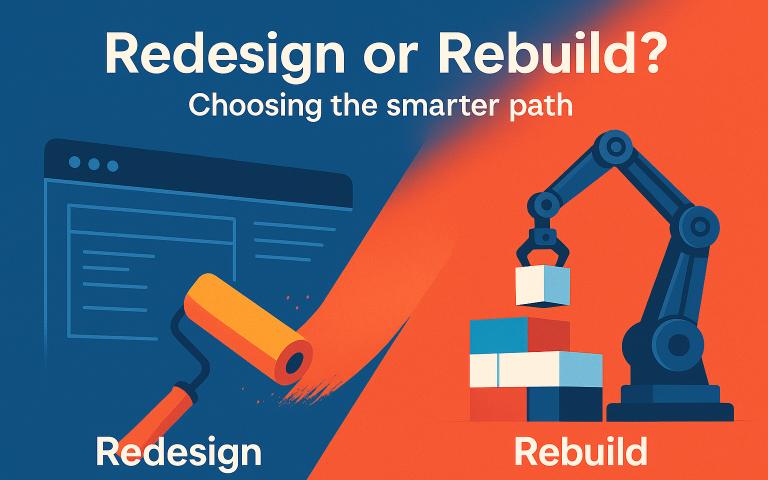Redesign or Rebuild: Which One to Choose?
When a website feels dated or struggles under new demands, you reach a familiar fork in the road: repaint the walls or rebuild the house. We start with redesign because it’s faster, friendlier to budgets, and safer for existing traffic.

Yet every foundation has limits—architecture, performance, and security eventually draw a hard line. This article isn’t a checklist; it’s a calm walkthrough of how to see those limits, where redesign truly shines, and when a clean start saves years of maintenance while protecting SEO and sanity.
A situation you’ll recognize
The site still runs, but excitement is gone. The UI shows its age, the team asks for payments and booking, marketing needs languages and trustworthy analytics, and performance dips at the worst time. The natural instinct is to “freshen things up.” That instinct is often right—provided the structure underneath is healthy.
Why we start with redesign
Redesign thrives when the foundation is sound: a supported CMS, a predictable codebase, and a URL/data structure that already earns search traffic. In that context, a modern interface lifts conversion quickly, while small features—SSO, better forms, a clean CRM bridge—slot in without surgery. You gain speed to value, preserve rankings, and avoid spending on rewriting what already works.
Where redesign hits the ceiling
Sometimes “just a tweak” becomes open-heart surgery. Subscriptions, granular roles, heavy workflows, or microservice-level scaling tug at the very base—orders, entitlements, queues, storage. If one feature forces a rewrite of half the core, the “quick redesign” stops being quick. Legacy stacks make Core Web Vitals, security, and scale a constant uphill battle. Over time, patches cost more than starting clean.
Deciding without drama
Project your product two to five years out. If the win is primarily UX polish plus a handful of clear features, redesign is a smart, economical move. If the roadmap includes serious roles/permissions, complex processes, deep integrations, multi-region traffic, or high load, a new foundation pays back. It’s not perfectionism—it’s choosing an investment that won’t crack under the next reasonable request.
Quick Checklist
Start with a redesign if:
- the platform is supported and stable;
- ≥60% of the scope is UX/UI and content, not core rewrites;
- required features fit without breaking the architecture;
- preserving current SEO and URL structure matters;
- time-to-value is critical and you need a quick conversion lift.
Switch to a rebuild if:
- the stack/platform is legacy or can’t meet performance/security;
- adding features would rewrite ≥70% of core modules;
- tech debt makes patches costlier than a clean start;
- the 3–5 year roadmap needs roles, complex flows, deep integrations, or high load;
- Core Web Vitals won’t be achievable on the current foundation.
Five questions before you begin:
- Over the next 12–18 months, do we optimize for speed to launch or scalability?
- How much core code are we willing to rewrite for near-term features?
- What happens to SEO and links under each option?
- Where are security risks and maintenance costs higher a year from now?
- Can the 3–5 year roadmap fit the current architecture?
We default to the lightest touch—redesign first. But when the architecture stalls growth, a rebuild isn’t developer vanity; it’s how you save time, budget, and focus over the long run. A clear diagnostic before kickoff beats any slogan.
Get in touch
Need an external audit of Your project?
Tell us your context and the outcome you want, and we’ll suggest the simplest next step.